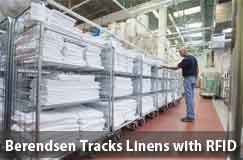SCDigest believes that in the end, RFID will eventually replace bar coding for most supply chain applications, because it's just better (no line of site required, automated reading capabilities, etc.)
But it may take many years for that change to happen, as for many applications the ROI from an investment in RFID is still very fuzzy, especially in replacing a working bar code system.
Supply Chain Digest Says... |
 |
| Could bar coding have enabled this level of tracking and analytics? Absolutely not in this application. |
 |
What do you say? |
| Click here to send us your comments |
 |
| Click here to see reader feedback |
|
|
However, in some cases the automated nature of RFID reads can enable the technology to solve problems that bar coding would simply not be able to address.
Case in point: textile management company Berendsen in the UK, which handles laundry services for items like towels, tablecloths, sheets and more its hotel, restaurant and hospital and other customers across Northern Europe.
Berendsen literally manages millions of such textile items every day, and knowing what inventory is where and where items are in the laundry cycle is, not surprisingly, a tremendous challenge, as recently reported by the UK's V3 web site.
As many as a million items a year were going missing, a Berendsen manager told V3.
"We have material coming and going at all times, usually over a million items a day are being processed. This means that keeping tabs on everything was very hard," said Duncan Macmillan, IT director at Berendsen.
He added that ""We wanted to know, do we get it back, how fast do we get it back, how long does it last, and how long does it take to go through the linen cycle."
With as many as a million items going through the laundry process in a given day, scanning individual bar codes for tracking is simply not possible. But by embedding RFID tags right into the linens, the items can be automatically tracked in large quantities as they go out to customers, come back to Berendsen's facilities, go through the laundering process and go back to customers.
The company has been experimenting with RFID for many years ago, but mass deployment was limited by the challenge of finding a tag that would survive many laundering cycles over a linen's lifetime, including not only the washing processes itself, but also in some cases being squeezed in giant presses to get the water out of the items.
Eventually, though, the company a tag technology from US company Tagsys that could withstand the processing.
(See More Below)
|
CATEGORY SPONSOR: SOFTEON |
|
|
| |
|
|
"A few [tags] will fail but by and large they outlast the linen, which is what we need," Macmillan said.
"We want to know how much stuff we've got coming in each day as soon as possible so we can process it and get it back out to customers," Macmillan added.
 He says Berendsen is able to scan huge batches of linens, as many as 1,000 at a time, and quickly get a sense of how many items it has at any moment and which orders can be fulfilled. He says Berendsen is able to scan huge batches of linens, as many as 1,000 at a time, and quickly get a sense of how many items it has at any moment and which orders can be fulfilled.
"It also means we can ensure when we send a batch to a customer there is the right number of sheets included," Macmillan noted.
This not only helps the firm keep tabs on what is coming and going, but what needs to be returned too, as sometimes customers have more linens than they really need.
Berendsen is using Microsoft's Azure Cloud platform to handle and manage all the RFID data. While the company has already improved its inventory management processes from the RFID-based tracking, it believes it can gain further insight from all the data.
"The average piece maybe lasts for 200 washes so by tracking its lifecycle we can see if it's only had 100 washes and is damaged something may be going wrong, or if it's still being used after 300 washes maybe it needs replacing," Macmillon said, adding that "We can now understand what is going on with our half of the linen cycle and ask 'how long is it lasting, is it being used as best as possible, are there items we have not had back,' and so on."
The company expects to add additional analytics over time based on the RFID data.
Could bar coding have enabled this level of tracking and analytics? Absolutely not in this application, the scanning process is too manually intensive, and it would be almost impossible to have enough process discipline to ensure all linens were scanned even if a company tried.
While Berendsen has processes not common in terms of general inventory management, there may be many other businesses with similar bar code tracking challenges that could also benefit from adopting RFID.
Are there many applicaitions for tracking that will just not work with bar coding? Let us know your thoughts at the Feedback button below.
Your Comments/Feedback
|